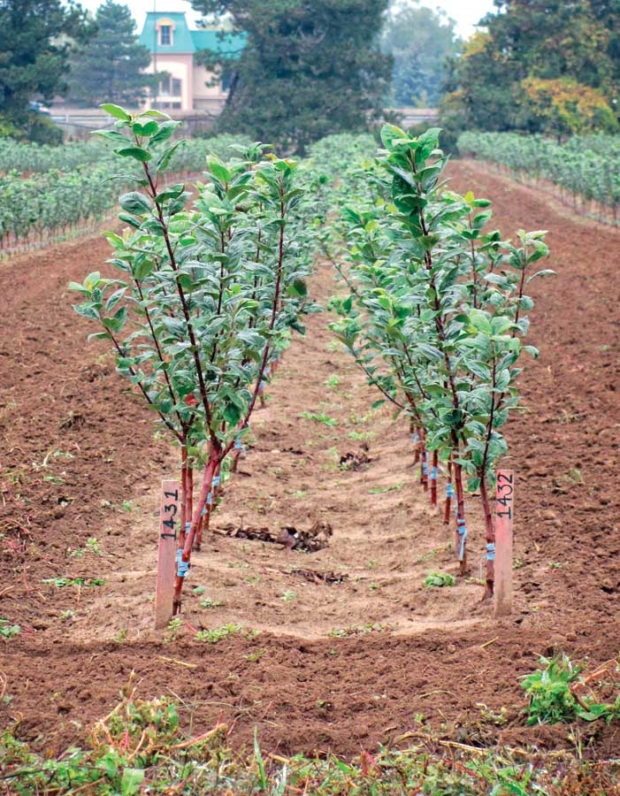A team of researchers is hoping to find the next stellar apple variety by matching the DNA fingerprints of consumer preferences with the genetics of thousands of seedlings in a test orchard overlooking Lake Ontario in Canada.

Researcher Daryl Somers has developed a test orchard of approximately 11,000 trees at the Vineland and Innovation Research Centre in Vineland, Ontario. (Peter Mitham/ for Good Fruit Grower)
“If I told you that a certain apple had a certain amount of sugar in it, and three of us tasted it, we might all say, ‘That’s really sweet,’ ‘Not so sweet,’ or ‘I don’t taste the sweetness,’ because we all respond differently,” said Daryl Somers, research director of applied genomics at the Vineland Research and Innovation Centre in Vineland, Ontario. “If I want to make a sweet apple, I don’t necessarily measure the amount of sugar. I measure your reaction for sweetness.”
A panel of 10 tasters was presented with approximately 80 varieties of apples in the center’s sensory laboratory, run by Amy Bowen, research program leader.
The tasters described the sensory attributes, allowing Somers and doctoral student Beatrice Amyotte to understand how the apples were perceived and to match those perceptions with detailed genetic sequencing information for those same apples through a genome-wide association study (GWAS).
The study “led us to essentially create new DNA fingerprints for how people perceive apples when they taste,” Somers said. “We’re connecting our genomics and our DNA sequence information directly to human perception and human sensory analysis. To my knowledge, that’s never been done before in apples, and I think you’d be hard-pressed to find it in any edible plant species.”
The exercise promises to be a boon for apple breeders, because they’ll be able to narrow their search for apple varieties that will resonate with consumer preferences. This will ease matchmaking among parent varieties and make better use of the center’s 7-acre test orchard.
“It allows you to focus and enrich the population for the higher quality apples that you’re looking for,” Somers said.

Young trees stand in the seven-acre test orchard at the Vineland and Innovation Research Centre in Vineland, Ontario. (Peter Mitham/ for Good Fruit Grower)
In spring 2015, for example, Somers sprouted 15,000 seedlings in a greenhouse. That summer, genomic analysis eliminated 6,000 of the seedlings from consideration.
Last fall, a mere 6,400 were budded onto rootstock, boosting the center’s trial orchard to nearly 11,000 trees.
The planting was more than in any previous year, but it was also a richer, more accurate selection of what might be successful in the marketplace, making for a more effective breeding program.
“You’re making much better use of your acreage,” Somers said. “If you stick with the same acreage, and you increase your chances of success, you’re simply more likely to produce a more marketable, high-quality apple at the end of the pipe when you’re all finished.”
Somers hopes to eventually plant 22,000 trees in the test orchard at Vineland, a former provincial research station that was long managed by the University of Guelph in Ontario and now operates as a public-private partnership.
The apple breeding program was launched in 2009 with the goal of revitalizing the Ontario apple industry.
“We asked our growers how we go about refreshing the variety mix in Ontario and in Canada, and everything pointed toward plant breeding,” Somers explained.
While federal apple breeding activities were consolidated at the Pacific Agri-Food Research Centre in Summerland, British Columbia, climatic conditions in Ontario demanded local research.
While everyone wants an appealing, good-tasting apple, how to get that in the humid environment of Ontario was another matter. Traditionally, McIntosh, Gala, Empire and Red Delicious have dominated local orchards, but newer varieties, such as Ambrosia, Honeycrisp and others, have entered the market.
“Our focus is really just on apple quality, the taste experience,” Somers said. “You’ve got to come up with other properties such as storage and disease resistance, but at the outset, it’s really to generate a differentiated, high-quality apple.”
This is where he hopes the current research program, supported with three years’ worth of funding from industry, the province and the University of Guelph totaling Can.$220,000, makes a difference.
The new set of DNA fingerprints Somers has developed is already drawing attention, even though he expects it to be at least a year before he gets a taste of what the new seedlings yield on the palate.
A collaboration with Summerland fruit breeder Cheryl Hampson is on the horizon, and Somers hopes the national cooperation will yield international benefits.
“It’s a point of trying to unify some of the apple breeding in Canada,” he said. “We’re looking outside our borders, too, not just within Canada. You never know how marketable certain genetics might be in other jurisdictions.” •
All dollar amounts are in Canadian dollars; a Canadian dollar is worth approximately 78 U.S. cents as of May 2016.
– by Peter Mitham, a freelance writer based in Vancouver, British Columbia.






There is a mistake in this article. I, Cheryl Hampson, retired in April 2016, so the mentioned collaboration on the horizon cannot be with me.
Cheryl, our apologies for the error.